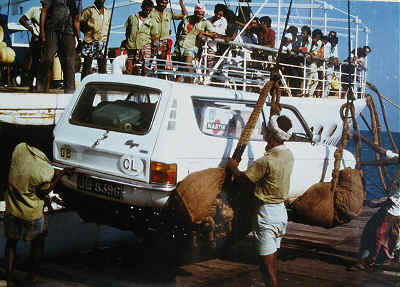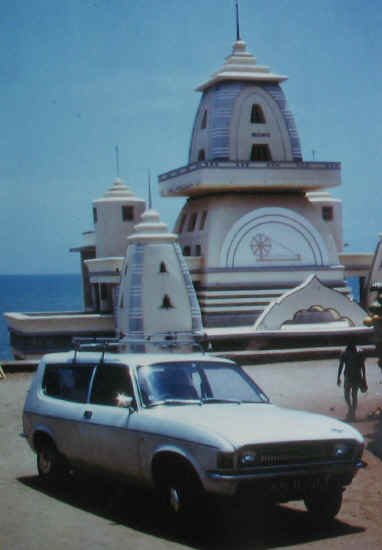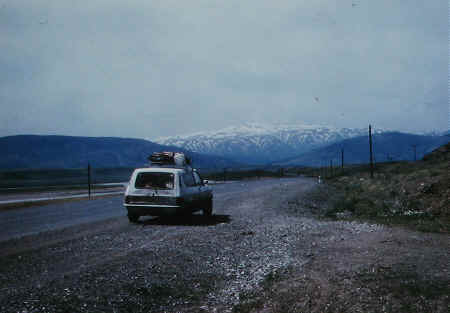| In 1975, I contracted to
work in Colombo, Sri Lanka and bought an Allegro 1300 Estate car to take with me. At the
time I was told that, as a home model, it was unsuitable for the Far East. Indeed, I had
to sign a form releasing the suppliers from all responsibility if anything went wrong. Now four years and 37,000 miles later, I can report a fair degree of
satisfaction with my purchase. Before taking delivery, I had expressed reservations about
defects on delivery with British cars, but in fact I received it with no observable
defect. For three years I drove it around the Island of Ceylon, and found it particularly
comfortable on their bumpy tarmac, much more so than other makes in the same class. I was
particularly pleased with the cooling system. Being sealed, it was several years before I
needed to add any water, and no overheating occurred even under the most extreme
circumstances. It climbed happily to over 6,000 feet in the central mountains, and only
once showed signs of strain in the hot humidity of lower altitudes - climbing steeply with
four very heavy occupants.
Climate-wise, the car's only disadvantage in tropical conditions is
the lack of rear windows. passengers in the back seat may find the heat uncomfortable. On
the other hand, in hot conditions, the accessibility of the engine is a great help.
In contrast to the absence of defects on delivery, two serious
defects emerged after a few thousand miles running. Rough engine performance indicated an
upper engine inspection, and a valve spring was found broken. Shortly after, the clutch,
groaning as though in pain, turned out to have a distorted throwout bearing, caused
apparently by defective assembly of the operating mechanism.
My contract finished, I decided to drive back to England overland,
to the disbelief and alarm of relatives and friends ('surely not in an Allegro!') I set
out from Colombo on the 7th March 1979 and arrived home on the 12th June, some four months
later. The direct distance from Colombo to Selsey, West Sussex, is about 7,800 miles.
However, after extensive touring in India, we actually clocked nearly 12,000 miles. I
undertook the first part of the journey on my own, and my wife joined me in Delhi for the
transcontinental section.
On the second day from Colombo, I crossed to India by sea ferry from
Talaimannar to Rameswaram, a journey of four hours or so. This was possibly the most
uncomfortable part of the whole trip, particularly as we were kept on board in the hot sun
several extra hours, while many thousands of pilgrims passed through the Rameswaram
customs shed on their way in small boats to a Hindu festival on the Sri Lankan side.
 |
The method of loading the car
on the ferry, by placing nets under the wheels, seemed effective and fairly free of risk.
But on the Indian side there is no jetty, and the car was unloaded on to a raft and towed
ashore. If the sea is at all rough, this operation is impossible; cars remain on the ferry
and are taken back to Sri Lanka to try again another day. Having
beached the raft, owners are expected to drive their vehicles ashore over a shaky
collection of planks, and across the sandy beach to the customs shed. |
By the time I had completed the lengthy customs
formalities, it was dark; there was no room at the tourist inn, so I slept on a camp bed
beside the car, with my mosquito net suspended from a young coconut palm. The most
uncomfortable part of the crossing comes the following day, because there is no road
bridge across the narrow channel which separates Rameswaram Island from the mainland.
Vehicles and drivers are put into a railway truck for the 12 mile journey to Mandapam. In
my case, this only took about four hours, and I was allowed to keep the doors of the truck
open; but I had some friends who took eighteen hours, and who were obliged to keep the
doors shut.
 |
Once on the mainland, I travelled down to Cape Comorin, the
southern-most point of India, then up the Kerala coast on the west side of the
sub-continent, to Trivandrum, Cochin and Calicut.
At Kasaragod, I turned inland and went, often over mountains to
Mysore, Ootacamund, Coimbatore and Bangalore. All the roads had tarred surfaces, but after
last December's cyclone, condition in the Nilgiris were often bad.
At Cape Comorin, the southernmost point of India. |
After Bangalore I went steadily north, through
Hyderabad, a city boasting 1.5 million bicycles, where I arrived in the rush hour; Nagpur,
from where I visited the fine Kanha National Park and photographed wild tigers by day from
the back of an elephant; Jhansi, Cawnpore, Lucknow and Delhi. Up to this point I was
mainly visiting agricultural research stations, but with my wife's arrival, the emphasis
switched to sight-seeing and visiting old friends from Second World War days. We went to
Agra, Simla and Kashmir, spending a few days in the mountains near Srinagar.
In Srinagar we had our only accident. At an intersection, a
policeman held up his hand , and I stopped by instinct, forgetting that in those parts
drivers rarely pay attention to anyone in authority. The lorry driver behind me was so
surprised that he drove straight into the back of the Allegro. Apart from angry
remonstrances, there was little to be done, and we left the driver to the furious
policeman. We managed to straighten the back panels sufficiently to get the back door open
and the car back home.
Simla provided the only occasion when the Allegro lacked performance
for its task. A half mile one-in-four entrance to a hotel, at 8,500 feet, with low octane
Indian petrol, was altogether too much for the engine when loaded, and barely possible
when the car was fully unloaded.
On leaving India, we had to decide if it was practicable to drive
across the Middle East. we met one or two caravanners and bus drivers who proposed to do
it, after hearing reports from other people who had come through the other way. Physical
security did not seem to be a major problem, apart from the risk of inadvertently driving
into the middle of a battle. More immediately troublesome was the risk of finding borders
closed for days or even weeks, and the almost total absence of petrol in Turkey. However,
the only alternative (apart from going all the way back to Colombo) was to ship the car
from Karachi or even Bombay. On investigation, both these options appeared exceptionally
troublesome and expensive, and we decided to risk the overland drive.
We crossed into Pakistan on May 15th and drove for four weeks direct
to Ostend. The first four countries were in varying states of turmoil and we did not do
much sight-seeing. In fact, Afghanistan was having a full scale civil war and outside the
towns we saw hardly anyone but soldiers.
We did not encounter any physical risks in Iran, but the
revolutionary atmosphere made people reserved. Services such as banks and hotels were
working normally, but the staff appeared to have taken over he hotels, and in some cases
sold off movable assets such as curtains.
Although Turkey was also under martial law, the atmosphere seemed
more friendly, the main worry being petrol. We had filled up at the Iranian border and
taken on 15 gallons reserve. Even so, if we had not managed to top up, by lucky chance, at
three remote wayside petrol stations, we would not have got across.

After Istanbul, the problems disappeared, and apart from narrow
roads and heavy traffic in parts of northern Greece and Yugoslavia, all was plain sailing.
from southern Austria, we were on motorway the whole way to Ostend and we came home, over
800 miles in the last two days.
Road conditions almost the whole way across the Middle East were
excellent. For many years the Russians and Americans have been playing war games in these
parts and this has provided a mutual interest in building highways along which troops can
be moved in a hurry. With the current reduction in lorry traffic, driving is easy. The
only exception is on mountain passes in Turkey, where the bitter winters have caused bad
break ups in some places. But even there, cars can avoid the Tahir Pass, for the cost of
an extra 37 miles, on an excellent new scenic road skirting the mountains on their north
side.
The entire journey was done on tarred surfaces and the low clearance
of the Allegro proved an embarrassment only on road repair diversions. But conditions in
India, even on main routes, were appreciably worse than on the rest of the journey. Often
the tar width will only take one vehicle and the edges are sharp and the verges rough; so
that every passing vehicle means two wheels on the rough, and often a speed reduction to
walking pace.
The only mechanical trouble arose from the Allegro's corroded
radiator, although towards the end of the journey we had trouble with a jamming starter
motor. The radiator had not tolerated well the high humidity in Colombo, particularly when
I had left the car unused during periods of home leave and I had not been able to get a
new one. I had to risk the corrosion not being too serious, but here I was caught out. In
the mountains of Coorg, I had boiling water spraying on my windscreen and my wife's
driving up a 9,000 foot pass in Eastern Anatolia was disturbed by jets of steam from the
front end. The locals of course have long experience of repairing radiators in such
places, but even so, ingenuity may be required to get the car to its surgeon.
Some replacements en route were inevitable. I started with two new
radial ply front tyres and after 2,000 miles I had to replace the rear tyres, using a
heavier duty 175 type. The front tyres had to be replaced near the Iran-Turkey border, but
I found it easy to get two new radial ply 165s in Iran, at a price. I had to replace the
battery in Hyderabad and the windscreen in Ankara, after a disagreement with a flying
stone.
On such a journey, it is advisable to know something of the workings
of one's vehicle, so that local mechanics do not have too much opportunity to fiddle and
to pinch useful parts. My biggest worry was encountering a problem which could not be
resolved with local resources, resulting in massive hotel bills, a difficulty which is
less worrying if one is camping. One also cannot afford to fall sick and we found the best
rule was to touch no water or drinks except one's own water supply. In some places, I
drank nearly two gallons a day and providing this would have been difficult if I had not
had an expensive but extremely simple and efficient silver core pocket filter.
Our friends say, it sounds fun in retrospect, but you
wouldn't do it again! Oh yes, we would!

Home at Last!
This account was written for British Leyland Motor Corporation, the
manufacturers of the Austin Allegro which Tim and Betty drove home - hence the car
featuring so prominently in the article.
Elisabeth Dening's Travel Journal |

